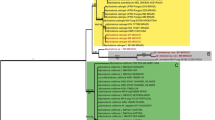Abstract
Identity of Ossicaulis lachnopus and O. lignatilis was studied using both classical and molecular methods. While O. lignatilis is a well-known species, O. lachnopus is almost unknown, having been resurrected to modern mycology by M. Contu in 2000. Based on collections from six European countries, both classical and molecular methods independently proved that the species really represent two separate entities. They form two well-supported clades that correlate to morphologically separable groups. The most important distinguishing characters are the size of spores, especially their length, and a pileus colour. O. lachnopus has small spores and a grey or beige-grey tinged pileus, whereas O. lignatilis has larger spores and a whitish to cream pileus, with a slight beige-greyish tinge at most. In this paper, we discuss taxonomy, ecology and distribution of both species and propose a preliminary key for their identification.






Similar content being viewed by others

References
Bas C, Kuyper TW, Noordeloos ME, Vellinga EC (eds) (1988) Flora agaricina neerlandica, vol. 1. A.A, vol 1. Balkema, Rotterdam
Baz J (2011) Ossicaulis lachnopus (Fr.) Contu 2000. http://www.micologia.net/gallery2/main.php?g2_itemId=152354. Accessed 14 December 2011
Breitenbach J, Kränzlin F (1991) Pilze der Schweiz, Band 3, Röhrlinge und Blätterpilze, 1. Teil. Verlag Mykologia, Luzern
Contu M (2000) Funghi della Sardegna: note e descrizioni. III. Boll Assoc Micol Ecol Romana 15(48):3–15, 1999
Contu M (2007) Funghi della Sardegna: note e descrizioni—VII. Micol Veget Medit 22(1):29–40
Eyssartier G, Roux P (2011) Le guide des champignons France et Europe. Belin, Paris
Fries E (1815) Observationes mycologicae, Pars 1. Bonnier, Kjøbenhavn
Fries E (1821) Systema mycologicum, vol. 1. Ex Officina Berlingiana, Lund & Greifswald
Gardes M, Bruns D (1993) ITS primers with enhanced specificity for basidiomycetes: application to the identification of mycorrhizae and rusts. Mol Ecol 2:113–118
Gröger F (2006) Bestimmungsschlüssel für Blätterpilze und Röhrlinge in Europa, Teil I. Regensb Mykol Schr 13:1–638
Hammer Ø, Harper D, Ryan P (2001) PAST: paleontological statistics software package for education and data analysis. Palaeontol Electronica 4:9
Hibbett DS, Vilgalys R (1993) Phylogenetic relationships of Lentinus (Basidiomycotina) inferred from molecular and morphological characters. Syst Bot 18(3):409–433
Holec J, Kolařík M (2011) Tricholomopsis flammula (Basidiomycota, Agaricales)—molecular taxonomy, delimitation, variability and ecology. Mycol Prog 10:93–99
Katoh K, Toh H (2008) Improved accuracy of multiple ncRNA alignment by incorporating structural information into a MAFFT-based framework. BMC Bioinforma 9:212
Kornerup A, Wanscher JH (1981) Taschenlexikon der Farben. Muster-Schmidt Verlag, Zürich
Krieglsteiner GJ (ed) (2001) Die Großpilze Baden-Württembergs, Band 3, Ständerpilze: Blätterpilze I. Verlag Eugen Ulmer, Stuttgart
Kühner R, Romagnesi H (1953) Flore analytique des champignons supérieurs. Masson et Cie, Paris
Kuyper TW (1995) Ossicaulis. In: Bas C, Kuyper TW, Noordeloos ME, Vellinga EC (eds) Flora agaricina neerlandica, vol. 3. A.A. Balkema, Rotterdam, pp 131–132
Lange JE (1936) Flora agaricina Danica, vol 2. Society for the advancement of mycology in denmark and the Danish botanical society, Copenhagen
Legon NW, Henrici A (2005) Checklist of the British & Irish Basidiomycota. Royal Botanic Gardens, Kew
Ludwig E (2000) Pilzkompendium, band 1. IHW Verlag, Abbildungen
Ludwig E (2001) Pilzkompendium, band 1, Beschreibungen. IHW Verlag, Eching
Matheny PB, Curtis JM, Hofstetter V, Aime MC, Moncalvo JM, Ge ZW, Yang ZL, Slot JC, Ammirati JF, Baroni TJ (2006) Major clades of Agaricales: a multilocus phylogenetic overview. Mycologia 98(6):982–995
Moncalvo JM, Lutzoni FM, Rehner SA, Johnson J, Vilgalys R (2000) Phylogenetic relationships of agaric fungi based on nuclear large subunit ribosomal DNA sequences. Syst Biol 49(2):278–305
Moncalvo JM, Vilgalys R, Redhead SA et al (2002) One hundred and seventeen clades of euagarics. Mol Phylogenet Evol 23:357–400
O’Donnell K (1993) Fusarium and its near relatives. In: Reynolds DR, Taylor JW (eds) The fungal holomorph: mitotic, meiotic and pleomorphic speciation in fungal systematics. CAB International, Wallingford, pp 225–233
Papoušek T (ed) (2004) Velký fotoatlas hub z jižních Čech [Large atlas of mushroom photographs from southern Bohemia]. T. Papoušek, České Budějovice
Phillips R (1994) Mushrooms and other fungi of Great Britain & Europe. Macmillan, London
Rambaut A, Drummond AJ (2007) Tracer v1.4. http://beast.bio.ed.ac.uk/Tracer. Accessed May 2012
Redhead SA, Ginns JH (1985) A reappraisal of agaric genera associated with brown rots of wood. Trans Mycol Soc Jpn 26(3):349–381
Ronquist F, Huelsenbeck JP (2003) MrBayes 3: Bayesian phylogenetic inference under mixed models. Bioinformatics 19:1572–1574
Roux P (2006) Mille et un champignons. Édition Roux, Sainte-Sigolène
Ryman S, Holmåsen I (1992) Pilze. Bernhard Thalacker Verlag, Braunschweig
Singer R (1986) The Agaricales in modern taxonomy, 4th edn. Koeltz Scientific Books, Koenigstein
Tamura K, Peterson D, Peterson N, Stecher G, Nei M, Kumar S (2011) MEGA5: molecular evolutionary genetics analysis using maximum likelihood, evolutionary distance, and maximum parsimony methods. Mol Biol Evol 28:2731–2739
Thiers B (2012) Index Herbariorum: a global directory of public herbaria and associated staff. New York botanical garden’s virtual herbarium. http://sweetgum.nybg.org/ih/. Accessed 15 April 2012
Vesterholt J (2008) Ossicaulis Redhead & Ginns. In: Knudsen H, Vesterholt J (eds) Funga Nordica. Nordsvamp, Copenhagen, p 506
Vilgalys R, Hester M (1990) Rapid genetic identification and mapping of enzymatically amplified ribosomal DNA from several Cryptococcus species. J Bacteriol 172:4238–4246
Wojewoda W (2003) Checklist of Polish larger Basidiomycota. W. Szafer Institute of Botany, Kraków
Acknowledgements
We thank Marco Contu and Scott A. Redhead for help with literature, and Giovanni Robich for information on type specimens. J. Holec's work was financially supported by the Ministry of Culture of the Czech Republic (project MK00002327201). M. Kolařík was sponsored by the grant MSM 6007665801.
Author information
Authors and Affiliations
Corresponding author
Rights and permissions
About this article
Cite this article
Holec, J., Kolařík, M. Ossicaulis lachnopus (Agaricales, Lyophyllaceae), a species similar to O. lignatilis, is verified by morphological and molecular methods. Mycol Progress 12, 589–597 (2013). https://doi.org/10.1007/s11557-012-0866-2
Received:
Revised:
Accepted:
Published:
Issue Date:
DOI: https://doi.org/10.1007/s11557-012-0866-2



